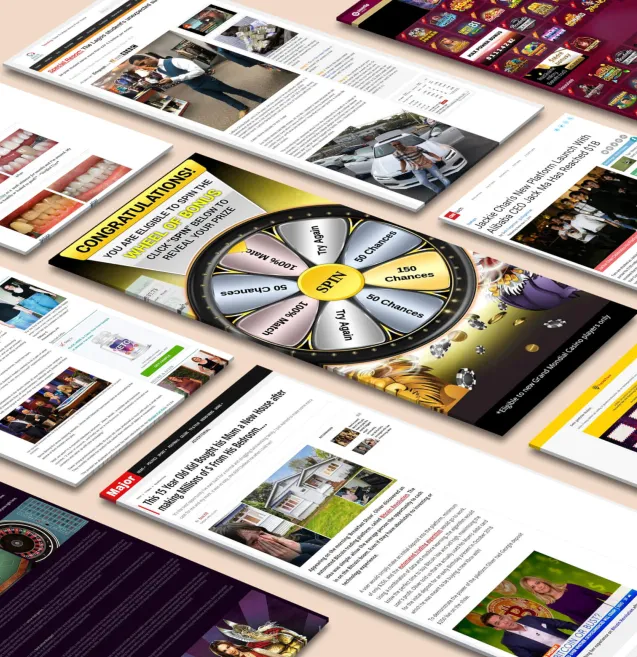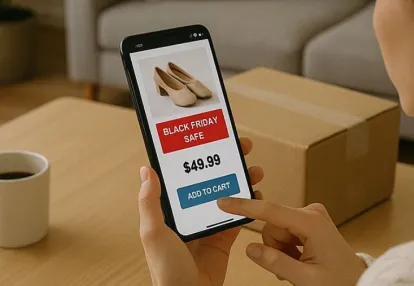
Our spy tools monitor millions of native ads from over 60+ countries and thousands of publishers.
Get StartedNative retail media is moving beyond static placements to become a helpful, story-driven layer of the shopping experience that customers actually value.
At its best, native retail media takes the signals shoppers produce as they browse and buy, and turns those signals into useful guidance right where decisions happen. With retailers sitting on rich first-party purchase data, brands can translate that truth into practical help—comparison modules on product detail pages (PDPs), utility-first stories in retailer apps, and credible on-site editorial. As third-party cookies fade, retailers’ data becomes the backbone for modern marketing intelligence that connects creative to outcomes.
Think of the shift this way: the old model paid to interrupt; the new model earns attention by assisting. If a sponsored product is a price tag, native content is a knowledgeable associate who understands the mission, budget, and constraints—and who can anticipate doubts before they turn into bounces or returns. The result is less friction, higher confidence, and baskets that grow because the shopper feels sure, not pressured.
Where does native show up today? Everywhere micro-decisions are made: dynamic cards on retailer app home screens, mission-based carousels in category results, PDP explainers that translate jargon into benefits, and editorial that teaches first and sells second. These are increasingly orchestrated by decisioning engines that choose the best variant for each audience and moment, often guided by an adaptive AI marketing strategy that learns from real outcomes.
Native retail media is content that feels like part of the store, not an ad bolted onto it. It inherits the retailer’s patterns (layout, tone, accessibility), honors the shopper’s immediate task, and adds value in the flow. A great native unit answers unasked questions: Will this vacuum fit under a sofa? How loud is it? What do people like me buy instead—and why?
Importantly, native is not just “it looks like the site.” It’s useful by design. Utility can be a 15-second “why this” explainer on a PDP, a quiz that helps size the right air purifier for a studio apartment, or a recipe story that one-taps an entire lunchbox set into the cart. Each format should resolve tension with evidence the shopper already trusts: ratings, Q&A, third-party certifications, and clear photos of real use.
Traditional display metrics reward visibility; native retail media rewards decisions. A small lift in PDP conversion can outweigh a large boost in top-of-funnel clicks because it happens at the moment of intent. Well-crafted native content reduces returns, increases attach, and raises average order value by clarifying trade-offs and showing fit.
Usefulness also compounds. When shoppers feel understood, they explore adjacent solutions. A cookware PDP that succinctly compares heat distribution and care requirements can unlock a premium trade-up today and an attach for utensils tomorrow. Measured over weeks, this shows up as higher repeat rate and lower churn in category.
App home screens and category hubs are prime terrain for mission-based storytelling. In the morning, a grocery mission might surface breakfast shortcuts; at night, quick-clean solutions. Treat these placements like always-on shelves: maintain a content cadence, rotate creative with seasonality, and sync featured items to live inventory and promos to avoid disappointment.
PDPs are the highest-intent real estate. Native modules should translate specs into benefits, defuse objections, and compare honest alternatives. Script your top five objections per hero SKU (too big, too loud, hard to clean, short battery, confusing setup) and counter each with concise copy, clear imagery, and proof. Accessibility matters: descriptive alt text, scannable microcopy, and mobile-first layout.
Guides, recipes, and brand spotlights can host fully shoppable narratives. Write for utility first: teach me how to choose the right stroller for city sidewalks, then show where your model fits the decision tree. Track engagement quality—scroll depth, dwell time, module interaction—alongside cart impact to see which chapters truly move decisions.
Retailers own a rare mix of identity, intent, and purchase truth. Activate it responsibly by building cohorts from observable behaviors rather than sensitive traits. Useful cohorts include new-to-category explorers, brand switchers, bulk stockers, value seekers, and premium upgraders. For each, hypothesize information gaps and friction points, then design native variants to close them.
Decisioning should consider context. If the user is new-to-category and on mobile at night, render a “2-minute guide.” If a repeat buyer has items in a baby registry, surface a “bundle-and-save” explainer with compatible accessories. If stock is low, emphasize alternatives with similar form factor and transparent availability. Guardrails keep it respectful: cohort-level logic over 1:1 creepiness, frequency caps, and never exposing sensitive inferences in the UI.
ROAS is a helpful snapshot of spend efficiency, but it often over-credits retargeting and underweights newcomer assistance. Native retail media needs a broader scorecard that ties exposure to durable business outcomes.
Incrementality: Did the exposure cause sales that would not have happened otherwise? Use geo-split tests, randomized eligibility when possible, or ghost ads. When experimentation is limited, difference-in-differences across similar stores or windows plus media mix modeling can triangulate effect.
Basket expansion: Did the shopper add complementary items or trade up to higher-margin SKUs? Define attach hypotheses upfront (e.g., water filter cartridges after a pitcher) and instrument time-to-next-purchase and sequence.
Quality: Are we seeing lower returns, better reviews, and higher repeat rates? These outcome metrics reflect whether native content truly clarified decisions, not just drove clicks.
Report efficiency metrics (CPM, CPC, cost per exposed) alongside effect metrics (conversion lift, AOV lift, category share gain). Establish a north-star KPI per initiative, such as trade-up rate for a premium launch or unit share at stable margin for value defense. Pre-register minimum detectable effect and power for experiments before launch to avoid “storytelling with noise.”
Before any native unit goes live, ask three questions: Does it clarify a decision? Does it reduce risk? Does it save time? Replace chest-beating adjectives with concrete facts—“picks up 99% of fine dust in one pass (internal lab test)” beats “best-in-class suction” every time. Link supporting proof in PDP assets and ensure claims are compliant.
Structure micro-narratives as situation (what mission is the shopper on), tension (common doubt), resolution (how we help), and next step (what to try now). Let visuals carry weight: show the product solving the precise tension. Write to a 6th–8th grade reading level and respect skimmers with scannable subheads and microcopy.
Translate capacity into relatable outcomes (“three full outfits per load”), show real placements in tight closets, compare noise to common benchmarks (“like a quiet conversation”). Attach compatible stacking kits and vibration pads. Measure trade-up in laundromat-heavy ZIPs and post-install reviews mentioning “quiet.”
Use app stories to guide a quick diagnostic (“fine lines,” “dullness,” “sensitivity”) then serve cohort-specific tips on the PDP. Editorial explains ingredient science in plain language and shows AM/PM routines. Track regimen basket growth and 60-day repurchase.
Run recipe-led editorial with one-tap add-to-cart, and PDP modules that call out real-world value (“packs 10 lunches”) with storage tips. Measure household penetration in families with kids and attach of reusable containers.
Native credibility is fragile. Align with retailer privacy policies, keep PII within retailer walls, and prefer cohort logic to 1:1 targeting. Creative QA should test logic paths as well as fit and finish: does the card make sense if the item is out of stock? Does it render in dark mode? Is the claim still compliant across variants and locales?
Operationally, success is cross-functional. Brand, shopper, eCommerce, analytics, and retailer partner teams should share a brief, creative taxonomy, and measurement plan. Build a component library (icons, claim snippets, image crops) so updates propagate across placements with minimal rework. Ask your retailer for a pre-flight checklist of specs (image ratios, character counts, CTA styles) and an SLA for reporting that separates reach, exposure, and effect—with access to raw logs when possible.
Expect a mix of pricing models: CPM with guaranteed exposure, CPC, and outcome-based structures like cost per add-to-cart or incremental conversion. Bid to measured effect, not just click propensity. If a PDP explainer boosts trade-up measurably, it may warrant a higher effective CPM than a top-of-funnel banner with cheap clicks.
Guard against frequency fatigue. Native’s strength is subtlety—overexposure turns it into clutter. Set soft caps per user per week, build decay that favors fresh variants, watch for saturation in small categories, and rotate to discovery cohorts when performance plateaus. Coordinate with offsite channels so native content complements search, social, and video—not competes.
Vanity claims without proof: If you can’t substantiate it with ratings, certifications, or tests, reframe as a concrete benefit with outcome and source. “Faster drying” becomes “dries a full load in 45 minutes (lab tested).”
One-size-fits-all creative: Don’t reuse the same hero asset everywhere. Crop for placement, rewrite for mission, and test variants that address each cohort’s doubt.
Chasing clicks over decisions: A unit that reduces returns or increases attach can be more valuable than one with a high CTR. Align on effect metrics before creative is built.
Write to real objections you’ve heard in reviews and Q&A. Show scale with human-context photos. Use comparison tables sparingly and label rows in shopper language, not spec jargon. Swap adjectives for numbers and proof points. Keep microcopy under 120 characters and prioritize scannability on mobile. Finally, leave room for surprise and delight—small animations or micro-interactions can make helpful content feel alive without becoming gimmicky.
Generative tools will accelerate copy, image crops, and variant production, but taste and governance will still separate winners. Expect retailers to expand template-driven native modules that brands populate at scale, with decisioning that learns which story gets which shopper to the next best action. Richer shoppability—interactive comparison widgets, AR try-ons, and creator-led live modules—will resolve doubts in real time. The common denominator remains: usefulness wins.
Native retail media is the natural evolution of advertising inside the store of the future. When brands stop buying attention and start earning trust—through context-aware assistance, respectful personalization, and rigorous measurement—they grow faster and more defensibly. Start with one shopper mission, build a few great native modules, test for incrementality and basket impact, then scale what proves useful. For creative inspiration and competitive research, tools like Anstrex can help you study patterns without copying playbooks. The next era belongs to marketers who tell better stories precisely where decisions are made.
Receive top converting landing pages in your inbox every week from us.
Quick Read
This blog analyzes post-Black Friday ad data to uncover key insights into evolving 2025 consumer behavior. It highlights shifting buying patterns, preferred ad formats, and the factors driving purchase decisions this season. Readers will gain valuable takeaways to refine their future campaigns based on real performance trends. Ideal for marketers seeking data-driven strategies to stay ahead in the competitive digital landscape.
Liam O’Connor
7 minNov 23, 2025
Quick Read
Generative AI is changing the way marketers create content, gain insights, and find solutions. It uses complex algorithms to analyze large amounts of data and generate outputs that mimic human thinking. This technology is a game-changer for marketers who want to automate and personalize their strategies on a larger scale than ever before.
Priya Kapoor
7 minNov 14, 2025
How-To
Native advertising has transformed the digital marketing landscape by seamlessly blending promotional content with the organic user experience. Unlike traditional banner ads that interrupt your browsing, native ads integrate naturally into the platform's content flow, making them feel less like advertisements and more like valuable information.
Elena Morales
7 minNov 8, 2025




